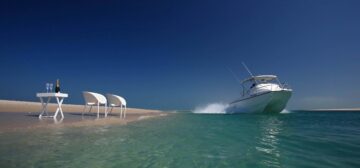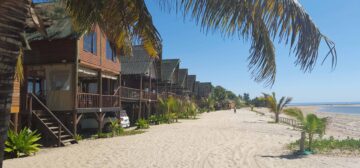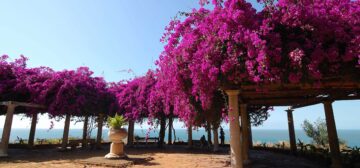Mozambique
With 2,500 km of coastline, this beautiful country offers spectacular scenery, excellent water activities, and some of the world’s best diving sites.
General Information
Despite Mozambique’s turbulent history, a great deal of work has been done since the end of the civil war to rebuild the infrastructure. Attractions centre on the coastline with long stretches of pristine, white sand beaches and shallow, warm waters with extensive coral reefs. Inland areas are yet to be fully developed for tourism, and wildlife populations are still recovering from the civil war, but great potential exists for the wilderness areas which centre on the inland plateau and mountain ranges. Most holidays to Mozambique are based around fly-in arrangements, but the roads are also of a good enough standard for self-drive visitors.
Geography – Environment
This slim country, with over 2,500km of coastline, winds its way along the beautiful, south-eastern edge of the African continent. Mozambique has borders with South Africa and Swaziland to the south, Zimbabwe to the west and Zambia and Malawi to the northeast. A remote boundary with Tanzania exists in the extreme north where a crossing is only possible across the Rovuma River.
The south of the country is dominated by the Mozambican Plain where extensive stands of beautiful trees cover the savanna. The Mozambican Plateau is found in the central and northern areas of the country and is characterised by rugged highlands and deep river valleys. Most tourism is concentrated along the coastline, although the inland areas will also have much to offer when wildlife numbers have recovered, and infrastructure has developed further.
The Zambezi River reaches the Indian Ocean in Mozambique, after entering the country at Feira where the flow is curbed by the 270km long Lake Cahora Bassa hydroelectric project. The Zambezi continues to meander its way to a 100km wide delta and into the Ocean. Other major rivers in Mozambique include the crocodile dominated Incomati, Limpopo & Save in the south and the Licungo, Ligonha, Lurio, Lugenda & Rovuma in the north.
The countries highest peak is Binga at 2436m and part of the Chimanimani range which forms the border with Zimbabwe. Mozambique’s climate is influenced by the warm, Indian Ocean current moving south from the equator, in addition to the altitude of the Mozambican Plateau. The temperature is higher at the coast than the inland plateau and increases further north. The rainy season is from November to April and the Mozambique channel experiences tropical cyclones once every few years, the most memorable of recent years being the storms that caused so much destruction in 1999.
Much of the temperate forests that once covered the country have been destroyed by logging and slash and burn agriculture. However, extensive Mopane woodlands still dominate the southern plains where ancient baobab and woodland mahogany trees still flourish. Mangroves are an important ecosystem for many species including the Mozambique’s famous prawns. Unique in their ability to survive in the brackish water of tidal estuaries, Mozambique’s four species of mangrove are still found around the Save River mouth, the Zambezi delta and Quelimane.
More than 1200 fish species are found off the coast, most of these within the extensive and largely unspoilt coral reefs. Kingfish, mackerel & tuna form vital links in the food chain of the marine environment. The destruction of Mozambique’s wildlife during the civil war was unprecedented within modern day Africa. However, much is being done to reintroduce native species to the countries National Parks and elephant can be seen in the elephant reserve in the southern Futi Channel and in the far north along the Rovuma River. Rhino, buffalo, lion, and leopard are still present in very small numbers in Gorongosa National Park and the Zambezi delta regions. This area was the headquarters of Renamo from 1980 to 1986 and it seems that the native wildlife was the only food source for the guerrilla fighters.
Sea mammals were less affected by the war and whales, dolphins and rare dugongs can be seen in the sparkling waters around Ponta Malongane, Inhambane & Linga Linga. Mozambique is a birding paradise with over 900 species present south of the Zambezi River. There are seven proclaimed National Parks in the country; Banhine, Zinave, Gorongosa, Bazaruto Archipelago, Gili, Niassa and the newly created Limpopo Transfrontier Park. At present there is only tourism development in Gorongosa, Bazaruto and the Limpopo Transfrontier Park.
History, Culture and Politics
As in most of the surrounding countries, the San Bushmen tribes were the first inhabitants of the area now known as Mozambique. These nomadic, hunter-gatherer people were displaced by Bantu tribes moving down from the north following climatic shifts which resulted in the Sahara extending southwards. These people moved into the area between 200BC & 300AD. Arab traders began to discover the wealth of the country around 300AD and many alliances were made with local tribes, leading to intermarriage and extensive trade relations.
Today Mozambique is home to eight major tribal groups, the Tsonga dominate the south of the country, the Shona & Zambezi Valley tribes (the Chuabo, Sena & Nyungwe) live mainly in the central regions and the Yao & Makua-Lomwe are based in the north. Seventeen major ethnic languages are spoken, although Portuguese remains the language of commerce and technology.
Although English is rarely spoken by the adult population, many of today’s children grew up in refugee camps in nearby English-speaking countries. Catholicism is the religion favoured by the urban population whereas Islam is dominant further north. Organised religion was repressed during the country’s Marxist era, from independence in 1975 to 1990. As in many African nations, ‘western’ religion mixes with the traditional culture of ancestor worship and animism. Due to ancient links with Arab traders, Mozambique’s cultural and historical heritage is closer to Muslim northeast Africa than to southern Africa, and the European links have led to a lively Latin influence.
The name Mozambique probably originated from an influential Arab trader named Sheik Mussal A’l Bik. His base was on the island of Mozambique, and when the Portuguese made landfall here in the 15th century, his name was given to the explorers when local tribe’s people were asked the name of the island.
The Portuguese explorer Vasco da Gama first landed at Mozambique Island over Christmas 1497. A fort was erected on the island in the early 16th century and by 1550 Portugal had gained control of coastal trade from the Arabs. Colonial presence was concentrated on the coast with forts being built along its length and very few Portuguese venturing inland.
In addition to the huge quantities of copra (dried coconut flesh), cashew nuts, fish and ivory that were exported from the Mozambique coastline by the Portuguese, slavery was big business with around 1500 slaves being sent to France each year. Pirates from Madagascar raided Mozambique & Ibo Islands in 1808, also taking slaves. Slavery was eventually abolished in 1875. The British colonial powers became interested in Mozambique when the value of Mozambique harbour, the present day Maputo, became apparent. The area provided the safest natural harbour between Cape Town and Mozambique Island. The dispute was finally settled arbitrarily in favour of Portugal by the then French president. Portugal proceeded to move the capital from Mozambique Island to Maputo (previously known as Lourenco Marques) in 1902 and the colonisers enjoyed increased trade with South Africa.
During the latter stages of WWI, Portugal joined the allies to secure continued power over its colonies. Administration of Mozambique remained in the hands of Portugal with no power given to the settlers or African inhabitants. A military coup in Portugal took place in 1926 and the government was overthrown. The colonial act of 1933 made Mozambique part of the Portuguese state with a common law and a centrally planned economy.
Demonstrations for independence began in earnest after WWII and Frelimo (the Mozambican Liberation Front) was formed in Dar es Salaam in 1962. The party’s armed struggle was launched in 1964 and Samora Machel became the new commandant in 1969. A socialist revolt in Portugal in 1974 led to independence being granted to Mozambique on 25th June 1975. The Portuguese recognised Frelimo as the country’s new government despite a complete lack of elections or interim administration. Almost all skilled workers and administrators immediately left the country creating a state of utter chaos as the Frelimo members had little to no training or experience which would enable them to run a country.
Acts of sabotage by the Portuguese added to the complete lack of infrastructure as existing sewerage networks were filled with concrete and roads and buildings destroyed. 1977 saw the formation of Renamo, the Mozambican National Resistance, with the support of the Rhodesian government. Renamo’s prime objective was to destroy existing transport and communication links within the country, and they succeeded in spectacular style. The civil war between Frelimo & Renamo raged from 1977 until 1992 and destroyed the social and economic fabric of the whole country. Russian & East German ‘advisors’ were drafted in to offer assistance to the Frelimo government, but offered very little in terms of workable solutions.
In 1984 Machel and President Botha of South Africa signed the Nkomati Accord promising no support for each other’s armed insurrections. Samora Machel was killed in a plane crash in 1986, some believe this to have been no accident, and was replaced by Joaquim Chissano. In 1990, Frelimo announced a complete turnaround in policy and declared that they would pursue a market economy with privatisation of state enterprises and multiparty elections. This took the wind out of Renamo’s sails rather and a reluctant ceasefire was agreed upon in 1992. UN supervised, multiparty elections were held in 1994 with UN peacekeepers facilitating disarmament. Much work has been done to remove the landmines and most of the country is now safe in this regard.
The elections proceeded smoothly and Frelimo won, making Chissano the elected president of a now peaceful Mozambique. In November 1995, the country was the first country that was not a former colony to become a member of the British Commonwealth. The president’s disciplined economic plan was highly successful, winning the country foreign confidence and aid. While Mozambique posted some of the world’s largest economic growth rates in the late 1990s, it has suffered enormous setbacks because of natural disasters, such as the enormous damage caused by severe flooding in the winters of 2000 and 2001. Hundreds died and thousands were displaced.
In 2002, Chissanó announced he would not seek a third term and Frelimo’s candidate, independence hero Armando Guebuza, was elected president and sworn in on February, 2 2005.
Health & Malaria
This is one thing to be wary about while on your Mozambique Holiday. The whole of Mozambique is a malaria area and recommended prophylaxis should be taken. Your doctor can advise you on the best type for the area of travel and your personal requirements. However, taking prophylaxis will not guarantee that you will not contract malaria! The best way to avoid malaria is to avoid being bitten by the mosquitoes that carry the parasite. Only the females of one species of mosquito (Anopheles) carry the tiny parasite, and the greatest incidence of malaria is in areas of high population where there are many people for the mosquito to bite and pass the parasite between.
Mosquitoes usually bite between sunset and sunrise, so make sure that you are covered up during this time! Wear loose-fitting, long-sleeved shirts and trousers, use a good insect repellent and sleep underneath a mosquito net or in a tent/ room sealed with netting. If you do develop flu-like symptoms, or feel at all unwell, during your holiday or after your return home, you must make sure that your doctor knows that you have recently travelled in a malaria area. Malaria is not a serious problem provided people take adequate precautions and seek advice and treatment immediately if they feel unwell.
Hospital facilities are generally poor in Mozambique, especially in the north of the country. In cases of serious illness or injury, medical evacuation to South Africa may be necessary. You must make sure that comprehensive travel insurance is taken out before you travel, this insurance should cover any medical expenses, air evacuation and repatriation if necessary. It must also cover delay, curtailment, or cancellation of your holiday or any associated flights.
Water
Plenty of water must be drunk to prevent dehydration. We recommend 2-3 litres minimum, excluding beverages such as tea, coffee, juice, and alcohol. Dehydration can cause very serious problems, it is totally avoidable, so don’t let this spoil your holiday!
Climate
• Rainy season: November to April. Rainfall does not usually occur every day, and generally takes place in the afternoon with mornings being fairly clear.
• Summer: October to March with a high of 34 ° C and a low of 29 ° C.
• Winter: June to October with a high of 22° C and a low of 19 ° C.
Season Summer rainy season (November to April)
Pros: Quieter tourism period (except Christmas), lush green inland landscape, beautiful sunsets and stunning views of electrical storms.
Cons: Very warm temperatures, activities may be interrupted by rain, increased mosquitoes, Christmas is usually busy.
Season Winter dry season (June to October)
Pros: Cooler, clear skies, fewer mosquitoes.
Cons: Busier tourism period, cooler mornings and evenings.
Our personal preference would be for either May or early November as these times are neither too hot nor too cool. At these times, rain should not be a problem and the heat is not excessive. The coast is always beautiful!
Photography
Bring plenty of memory cards and a spare camera battery as these items may not be available in some of the more remote areas of Zambia. A good zoom lens (minimum 200 mm) is essential for wildlife photography.
Photography of government offices, airports, military establishments, residences and the police or officials is illegal without special permission from the Ministry of Information. If in doubt, do not take pictures. Laws are enforced.
Clothing
Light, cotton clothing is the most comfortable and visitors should be respectful to local culture by covering up and wearing long skirts, trousers or sarongs for women and a shirt and shorts for men when away from the beaches. Army camouflage uniforms or army hats are not recommended.
Recommended Packing
Light, casual clothing (shorts/shirts) for everyday wear, stout shoes for walking, light waterproof jacket for summer, warm jumper/ fleece for winter, warm long trousers for winter, two sets of good casual clothes for evening dining where appropriate, towel, broad brimmed hat, sunglasses, sunscreen, camera, plenty of film & spare battery, binoculars, reliable torch, sleeping bag if camping. Evening wear should be light coloured and loose fitting to discourage mosquitoes. Socks should also be worn at night as ankles are a favourite spot for insect bites!
It is also worth noting that if you are travelling by light aircraft you should carry no more than 10-15kg of luggage in a soft bag for ease of packing.
Currency
The unit of currency is the metical (MT, plural meticais). Coins are generally not used at all. US$ can be exchanged at banks or Bureaux de Change, as can Euro and pounds sterling. Most upmarket lodges accept credit cards, mainly Visa or Mastercard, although this should be checked before arrival.
Visa Requirements
You can purchase a single-entry border visa at major border crossings and international airports (valid for 30 days, non-renewable). Ensure you have sufficient cash as credit cards are not accepted. Some travellers have reported problems with this service (visas unavailable or taking a long time to be issued) and it is subject to change, often with no notice.





